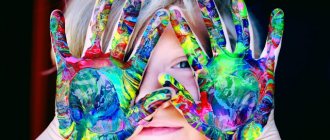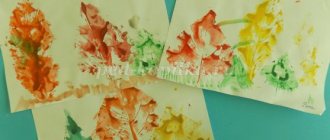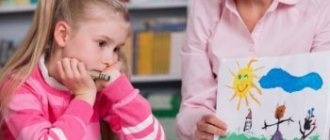In preschool age, all children love to draw; it helps them express themselves and comprehend the knowledge they have acquired about the world around them. That is why the development of creative abilities in visual arts is so effective and efficient.
For a long time, teaching drawing in childhood was considered almost exclusively as part of aesthetic education. However, at the end of the last century, psychologists finally recognized that visual activity is an important condition for the development of the child’s psyche, and not only creative abilities.
Children's development in visual arts
In the material you can see a selection of drawings by students of the author of the article, Marina Golubeva. Students made these images while doing the Draw a Sound activity. The results were very interesting drawings that illustrate how creativity and imagination come to life on paper.
Draw the sound - the sound of falling snow
The consciousness of preschool children, their thinking and worldview largely remain a mystery to teachers and psychologists. But studying the possibilities of developing creative abilities in visual activities led researchers to very interesting conclusions. It turns out that when a child is engaged in drawing, all mental processes are activated, including the development of creative thinking. But we are not talking only about this higher type of cognitive processes. The development of children in fine arts takes place in a variety of spheres and areas of the psyche.
- Drawing satisfies the most important needs of children: to communicate and understand the world, to express their emotions and relaxation.
- The development of fine motor skills of the hand in visual activities has a positive effect on all areas of the brain, activating thought processes.
- Development of visual memory: drawing not only ensures memorization and long-term preservation of images, but also stimulates their reproduction. Moreover, this happens directly, without connection with speech, which in children (and many adults) is not developed enough to convey all the details and nuances of visual images.
- The development of creative abilities in visual activity is also associated with the fact that drawing develops the skills of conscious, purposeful imagination.
- In preschool age, imaginative thinking plays an important role, and nothing develops it better than drawing.
Development of creativity in drawing – Call
The development of creative abilities in fine arts is not the only thing that determines the role of drawing in children’s lives. No less important is the fact that drawing has a huge psychotherapeutic effect. It helps kids relieve emotional stress, throw out negative emotions on paper, calm down and tune in to the positive.
Development of children's creative abilities through unconventional drawing
All children are researchers; they are passionate about learning previously unknown things and mastering new activities. Therefore, it is useful to use unusual techniques and develop children’s creative abilities through unconventional drawing.
Imagination on paper - clicking heels
The use of unconventional techniques and techniques helps children overcome fear and uncertainty, because they are still poor at using a pencil and brush, and they do not always like their own drawings. And failures greatly reduce motivation and interest in drawing and make it difficult to develop creative abilities in visual arts.
There are quite a lot of methods that are considered non-traditional, and they are intended for children of different ages. So, for the little ones the following are suitable:
- Finger painting is very useful in early childhood, as it develops not only imaginative thinking, but also tactile sensitivity.
- Finishing the drawing of handprints is very exciting and develops imagination and imaginative thinking.
- Using a variety of prints, which allows kids to admire the beautiful prints.
- Blotography is an absolutely amazing technique. Children love her very much, looking with delight at the original paintings created from simple blots.
- Drawing with sand allows kids to master a completely unusual material.
How to depict Rustle - draw the sound
“Development of artistic and creative abilities of preschool children in the process of productive activity”
“Development of artistic and creative abilities of preschool children in the process of productive activity”
Every child is an artist.
The difficulty is to remain an artist,
leaving childhood.
(Pablo Picasso)
Preschool age is the period when visual activity can become, and most often is, a sustainable hobby not only for especially gifted children, but also for almost all children, i.e. By captivating a child into the fairy-tale world of art, we, unnoticed by him, develop his imagination and creative abilities.
Interest in children's visual arts is determined by its importance for the development of the child's personality. One of the conditions for the manifestation of creativity in artistic activity is the organization of an interesting, meaningful life for a child.
According to V. Stern, a child’s drawing is by no means an image of a specific perceived object, but an image of what he knows about it. Children's art, according to psychologists from the Leipzig School of Complex Experiences, is expressive in nature - the child depicts not what he sees, but what he feels. Therefore, a child’s drawing is subjective and often incomprehensible to an outsider.
To understand a child’s drawing, it is very important to examine not only the product, the result of drawing, but also the process of creating the drawing itself. N.M. Rybnikov noted that for a child the product of visual activity plays a secondary role. The process of creating a drawing comes to the fore for him. Therefore, children draw with great enthusiasm. Small children depict little on paper, but at the same time they speak and gesture. Only towards the end of preschool age does the child begin to pay attention to drawing as a product of visual activity.
N.P. Sakkulina believes that by the age of 4-5, two types of draftsmen are distinguished: those who prefer to draw individual objects (they mainly develop the ability to depict) and those who are inclined to develop a plot, a narrative (for them the image is supplemented by speech and takes on a playful character). G. Gardner calls them “communicators” and “visualizers.” For the former, the process of drawing is always included in the game, dramatic action, communication; the latter focus on the drawing itself, draw selflessly, not paying attention to the surroundings. This contrast can be seen in specific children studying in the art studio. Children who are prone to the plot-game type of drawing are distinguished by their vivid imagination and active speech manifestations. Their creative expression in speech is so great that the drawing becomes only a support for the development of the story. The visual side develops worse in these children. Children focused on the image actively perceive objects and the drawings they create and care about their quality. their drawings.
Knowing these features, we can purposefully guide the creative manifestations of children.
In the process of visual activity, the formation of artistic creativity occurs, the development of which is impossible without teaching children how to artistically and figuratively embody ideas, convey objects and phenomena. This training is aimed at creating an artistic image by children and is closely dependent on the development of abilities for visual activity, changing the structure of the pedagogical process and methods of pedagogical leadership. This change assumes the role of the teacher as an assistant, a participant in creativity. The joint activity of an adult and a child takes on the character of co-creation, which at each age stage has its own function (a more active role of co-creation in the early stages and a gradual change in its content at older age stages, when the teacher takes the role of an adviser, partner).
At all age stages, the child’s personal position remains the main, leading one, and the teacher must take it into account.
The system of classes for preschool children in visual arts is aimed at teaching children to depict surrounding objects and phenomena, using for this purpose acquired visual skills and abilities, using available means of expressiveness when creating images and developing children's artistic creativity.
Visual activities in kindergarten are based on the unity and interconnection of three types: drawing, modeling, appliqué, which contribute to children’s more effective mastery of all these types of activities, as well as a warmer aesthetic development of children. The effectiveness of teaching, and consequently the development of children's creativity, creative abilities and comprehensive education of children in kindergarten depends on a number of conditions.
The main one is: building the learning process in accordance with the program, teaching methods aimed at children mastering all components of the activity and meeting joint requirements. Wide inclusion in the pedagogical process, in the lives of children, of a variety of artistic and creative activities, maximum attention and respect for the products of children's creativity, their widespread use in the life of preschoolers and the design of the kindergarten premises fills the lives of children with new meaning, creates for them an environment of emotional well-being.
By comparing their works, children are convinced of the advantages of one method or another, so they are prepared for an independent search for the best means of representation, and this in turn prepares children for creative activity, which is of a search nature. Based on the fact that each child must acquire a certain amount of knowledge, skills and abilities in an organized manner in classes and in independent free activities under the guidance of a teacher, work to familiarize children with artistic activities in kindergarten is carried out according to the scheme: leader-teacher-child.
Developing children's creative abilities, classes include the following activities:
1. Presentation of educational material (in the form of a game, conversation, excursion). The introduction of new methods of artistic activity, new materials through creative tasks that children solve together with the teacher and individually, contributes to the solution of educational problems and assignments.
2. Independent practical work of children, which is the basis in the educational process. Her goal is creativity. The creation of artistic images develops in children the ability to generalize them, lead to unity and integrity.
3. Discussion of creative works by children and the teacher helps the child to see the world not only from his own point of view, but also from the point of view of other people, to accept and understand the interests of other people.
When planning classes, it is necessary to choose one or another form of work for each topic, taking into account the complexity and volume and specifics of the art studio.
Thus, the presentation of the material can take place first in a group with a teacher, and then continue in classes in the art studio, or vice versa.
For example, the theme “Circus”, in order to draw it creatively, the children in the group are told a lot about the circus, during the conversation the children share their impressions of going to the circus, make sketches of clowns, animals with the teacher, and then in the lesson the children, showing creativity, create works - sculpt, draw, etc.
Given the specific nature of the topic, classes can take place in an art studio, or maybe in a music room. For example, if the final lesson is in the form of entertainment.
The results of work in this direction should be:
- children’s activity and independence in visual arts;
— the ability to find new ways for artistic depiction;
- the ability to convey one’s feelings in one’s work using various means of expression.
Education in visual arts classes is structured as an exciting problem-based game activity that ensures the child’s subjective position and the constant growth of his independence and creativity.
All classes are conducted in subgroups and are integrative in nature.
The pedagogical process also includes individual lessons with lagging children and lessons with gifted children. Club work can be carried out with gifted children twice a week. At club classes, gifted children receive additional, deeper information about the visual arts program, and most importantly, they acquire the opportunity for unlimited creativity.
In classes, close connections are established between all types of visual activities - drawing, modeling, appliqué, as well as decorative and applied work.
Children's education is structured as an exciting problem-based game activity that ensures the child's subjective position and the constant growth of his independence and creativity.
Activities in an enriched developmental pedagogical environment allow the child to show inquisitiveness, inquisitiveness, learn about the environment without coercion, and strive for a creative reflection of what he knows. So, during classes, children find themselves in interesting situations in which they need to figure out a way out themselves. During the lesson, children are asked questions: what do you think? What would you do? How do you imagine it, describe it, etc.
When preparing for his classes, the teacher thinks about what to do so that teaching images does not give rise to cliches and does not deprive children of the opportunity to depict something on their own?
It is obvious that children can and should be taught. But not the artistic technique of adults, but a new vision, a new plastic understanding of space. But be sure to take into account their age characteristics. We want every drawing or completed work to be filled not with educational content, but with children’s content, so that they reflect the child’s impressions, his attitude towards what he depicts. Therefore, in art classes, it is necessary to assign a large role to the sources of fantasy, creativity, and independence.
Conclusion
Creativity is an integral activity of the individual, necessary for every modern person and person of the future. And its formation can and should begin in the preschool period.
From the proposed understanding of creative abilities, it becomes obvious that for their development, children need to receive a variety of impressions about the surrounding life, nature, and familiarity with works of art.
Necessary conditions for the development of artistic creativity in preschool children are:
• priority attention to children's activities - play;
• the creative approach of the teacher to the selection of educational content based on integration, as well as to the organization of classes with children and to the use of a variety of methods and techniques in work;
• drawings, modeling, and appliqués made by children, both individually and collectively, should be widely used in the design of kindergarten premises;
• wide inclusion in the pedagogical process of a variety of games, game techniques and game situations, which maximally contributes to the creation of personally significant learning motivation for the child, mastery of material and development of creativity in children 3-7 years old;
• variability in everything: in the choice of lesson topics, organization of the environment (its novelty and diversity) in which work with children takes place, materials provided to them;
• exclusion of formalism, dryness, excessive didacticism, contrary to the specifics of art and artistic creativity;
• studying the individual characteristics of each child and, on this basis, implementing an individual approach or a person-oriented approach in teaching children visual arts and developing creativity;
• the relationship between creativity and learning, during which children acquire the knowledge, skills and abilities necessary for creativity.
The teacher must understand that the widespread inclusion in the pedagogical process of a variety of artistic and creative activities, maximum attention and respect for the products of children's creativity, their widespread use in the lives of preschool children and in the design of the premises of a child care institution fills the lives of children with new meaning, creates for them an environment of emotional well-being, evokes a feeling of joy, and must also understand that engaging in various types of artistic activities creates the basis for full meaningful communication between children and with adults, and one should strive to help them carry out such communication.
In creative activity, the teacher sees his task not so much in teaching children the fine arts, but in providing the foundations for the development of each child into a competent person capable of adequately thinking, feeling and acting in a cultural society.





